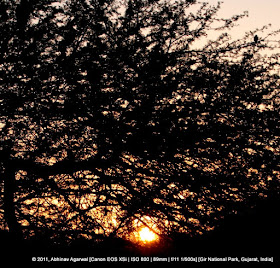
The truly majestic Asiatic lion now lives in the wild in only one place in Asia; in the western Indian state of Gujarat, within the protected confines of the Gir Forest National Park and Wildlife Sanctuary (Gujarat Tourism page on Gir, Wikipedia page on Gir). Where at one point in time the Asiatic lion could be found even in Northern Africa, today there are less than 500 Asiatic lions left in the wild, all of them in the 1400 sq kms that forms the sanctuary, of which about 250 sq km is fully protected.
This is the entrance to the park boundary when approaching the park from the eastern side. Basically this is where you would enter the park if you came from the Union Territory of Diu.
Contrast thy name is India. A shining black Audi luxury car, followed by a tractor with a huge sugarcane(?) load.
View Larger Map
One way, convenient if a bit less than ideal, is to visit the Gir Interpretation Center at Devalia. This is approximately 12 kms from the Gir sanctuary, and within a double-gate entry fenced enclosure you can take an hour-long safari. There are perhaps half a dozen to a dozen lions kept in the park, so the chances of spotting a few lions are very high. Not the same as seeing one in the wild, but given that you have to be patient to spot a lion inside the national park itself, you may want to use this as a backup. There is also the gift shop at the Devalia Interpretation Center where you can pick up some nice gifts.
From the main highway that runs skirting the park, SH 26, you take a right on to SH100A, where the Devaliya Interpretation Center and safari is. This photo below is SH100A.
This is one of the mini-buses that ply to the safari and back. You have a choice of air-conditioned and non air-conditioned buses. In winter months, and perhaps even otherwise, you are better off with the non air-conditioned buses, because that will allow you to open the windows and get a better view of the safari and lions.
Yes, the lion is a majestic animal. Truly the king of the jungle. When you come face-to-face with it, or at least that's what you like to feel from inside the bus, there is a slight shiver that runs through you the first time you spot a lion. A sense of awe. The majestic beast walks gracefully, majestically; it is the king of the jungle, and it seems to know that.
As you can see, there is enough open space, and the underbrush seems to be constantly cleared and burned to minimize the risk of a fire during the dry months.
At the Gir Interpretation Center at Devalia there is a small shop where you can buy knick-knacks and gifts. You can buy nice t-shirts, paper-weights, caps, pens, keychains, calendars with stunning photographs from the sanctuary, coffee mugs, and more.
This is the entrance to the Gir National Park. There are forest vehicles that take you into the park. The first batch of vehicles is let into the park shortly after 6AM; I shot this photo at 6:30AM, some half an hour before sunrise. The best chances of spotting a lion inside the park is in the early hours of the morning. As the day progresses, the lions retire into the deeper parts of the jungle, preferring to rest in the shade, waiting for nightfall to begin their hunting. As luck would have it, we spotted a lone lion less than a kilometer into the park. It crossed the road where our vehicles were, and sauntered into the jungle. Before I could realize it, the king of the jungle had vanished into the jungle.
Our vehicles stayed inside the park for more than two hours, driving at a leisurely pace. The biting cold did make it tougher to really enjoy the serenity of the jungle, but was no less memorable.
There is a tribe that lives inside the jungle; preferring to co-exist with the lions rather than the jungle outside. They are permitted by the government to live within the national park. These tribesmen are vegetarians.
The rising sun shines through the foliage and the trees.
A spotted owl, I think, sitting atop a tree.
A white tree; I forget the name. Pity.
And a bird on one such white tree.
The sign of the king of the jungle is as much to be celebrated as the king itself. If the lion were given to hyperbole, it would probably say, "hum jahan khade ho jate hain, line wahin se shuru hoti hai." And true it would be, since where the pugmarks of a lion are spotted is where the spotters in the park go to and look for the lion from.
There is one, and only one negro tribe that lives in India. It is the "siddhi" tribe, and these people migrated to India from Africa several hundred years ago. Their cultural identity is preserved via categorizing them as a "scheduled tribe", thereby guaranteeing them certain rights and freedoms within the Indian constitution.
© 2012, Abhinav Agarwal. All rights reserved.























